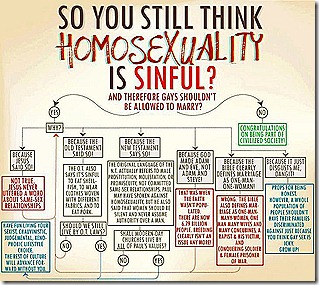
I recently saw this flowchart which appears to put a strong case for gay marriage using apparently irrefutable arguments referencing the Bible. In fact the whole argument is flawed but the chart is useful, nevertheless, in that it puts together in one place some of the most popular and familiar arguments Christians hear.
I see these flow charts from time to time, they assert something or other about faith issues, but clearly reflect the prejudices of the person who created them. Of course, they are popular because they are pleasing to people who have already made up their minds and enjoy seeing their views represented in such an apparently "scientific" way. The Bible, that people like to quote selectively to make these things work, has something to say about that as well.
To suit their own desires, they will gather around them a great number of teachers to say what their itching ears want to hear" (2 Timothy 4:3)
The chart says nothing about the complexity of Old Testament laws, the distinction between the moral laws that are eternal and the cultic/cultural/societal laws that are temporal and specific to Israel. It says nothing about their purpose and practice, and it fails entirely to compare like with like. But then it wouldn't because that is not the sort of careful and scholarly comment intended. The point is to make the point by whatever means.
The chart’s author begins with their conclusion then produces familiar enough arguments aimed specifically at making gay relationships look reasonable and good, and Christian arguments to the contrary wacky and even unbiblical - "Isn't it ironic, they don't even understand their own Bible?"
I have no problem with people who take the pro-gay marriage view, although I disagree profoundly with them. After all, we are blessed to be living in a liberal democracy, a pluralistic society that accommodates as many viewpoints as possible. But I do object to the way the conclusion is arrived at because it misrepresents the Bible and because it presents a mischievous, or at least careless, idle method, a method that is misleading and confusing. Let me demonstrate by addressing each biblical argument that the author claims to refute.
“The Old Testament says it is sinful to eat shellfish, to wear clothes with different fabrics and to eat pork: Should we still live by Old Testament Laws?”
So the chart informs us. The “obvious” answer on the face of it is "No,” since even Christians eat shellfish and pork and the reader is congratulated for arriving at this answer, being called, “part of civilised society.” Those who answer “Yes” are deemed, “sexist, chauvinistic, judgemental and xenophobic.”
But the Old Testament also says don’t murder, don’t steal, don’t commit adultery, don’t give false testimony, don’t follow the crowd in doing wrong, don’t pervert justice or deny justice to your poor in their lawsuits. So by answering “No, we should not live by Old Testament laws” what does that make you? You see, it isn’t so straight forward.
This is because, as well as giving Israel eternal statutes, God also gave civil or national laws as well as cultic laws pertaining to the temple. The rule about mixed fabrics (Lev.19:19) is not nearly as wacky as it at first appears to a modern reader but is understood by some to be a living mnemonic to help Israel remember to not mix their culture and religion with the pagan societies around them (see Ezra 9:1)
Dietary laws too had religious/cultic significance as well as possible health applications. Some applications are obscure, lost in the mists of time because peculiar to one nation in one historical period. Moral laws such as correct sexual relationships are not cultural, according to Scripture, but universal and eternal.
So the answer to the question, “Should we still live according to Old Testament Laws?” must be a thoughtful, qualified and informed “Yes and No.”
“God Made Adam and Eve, Not Adam and Steve.”
The Adam and Eve argument is very misleading since it fails entirely to address the original point and changes the subject from the identity and gender of our first parents to the question of populating the earth.
It is true that the product of a healthy marriage is offspring but marriage is much more than a means of reproduction. Marriage serves as a picture of the relationship between God and his people (Jer.3; Ezk 16) between Christ and his Church (Eph.5:22-33). Being made “in God’s image” is to be made with the natural capacity for relationship.
As though to underline what sort of relationship God didn’t only make Adam and Eve, he made Abraham and Sarah, Isaac and Rebekah, Jacob and Rachel, Boaz and Ruth, David and Bathsheba and Joseph and Mary. The list can be added to but what cannot be added to the list is any biblical example of God making “Adam and Steve,” the original point deceptively side-stepped in the chart. If we are going to have this discussion we must engage with what God says and does and not what we would like the text to imply.
“The Bible clearly Defines Marriage as One-Man-One-Woman.”
The argument is made that various models of marriage are to be found in the Bible including monogamy, polygamy, concubines, etc. Why not same-sex marriage? It is good to remember that some people are in the Bible as an example, some are in there as a warning.
The Bible is not, as some think, “a compendium of divine teaching out of which doctrine can be mined and pieced together in a systematic fashion,” as Timothy Ward points out in his thoughtful and well written book Words of Life – if you want to understand what Scripture is, and isn’t, I highly recommend Timothy Ward’s work.
The Bible is not a simple book of rules for living. Through poetry and prose, history and narrative, parable, statute, prophecy, apocalyptic writings the Bible doesn’t just tell, it shows. It can be said to proscribe, prescribe and describe and the mistake here is in confusing these.
Just because the Bible describes something – Jephthah’s vow for instance (Jg.11:34), or the wives of Solomon for example – doesn’t mean God prescribes what is described. In the case of Jephthah we have a salutary lesson in the folly of making rash and ill-considered vows, in Solomon’s the disastrous nature of polygamous marriages is demonstrated (1 Kings 11:4-10, c.f. 9:6-9)
God made Adam and Eve. If he had made Adam and Eve and Sarah and Emma, and Mary etc. then marriage as a picture of the relationship between God and his people would fail and man could with impunity go after other gods as he goes after other women. That idea is scotched immediately by the first three commandments (Exodus 20:3-7)
At the other end of the Bible we see again monogamy being taught and modelled.
“An Elder should be the husband of but one wife…” (1 Tim.3:2; Titus 1:6)
“A deacon must be the husband of but one wife” (1 Tim.3:12)
We can safely conclude that God prescribes monogamous marriage and the Bible describes man’s departure from God in doing otherwise. Homosexual relationships are, likewise, a departure from God’s purposes in creation.
“Because the New Testament says so”
It is mischievous to simply assert, as the author of this chart does, that “the original language of the New Testament actually refers to male prostitution, molestation, or promiscuity, not committed same-sex relationships” - everything in this chart is an assertion and no serious attempt is made to engage with the complexity of the arguments, to give references or to show method.
None of the four gospels touches this issue it is worth noting. Neither do other important books of the New Testament, i.e. Acts, Hebrews, Revelation. This doesn’t mean that Jesus and most New Testament writers hadn’t a problem with homosexual practice and an argument from silence cannot be reasonably made.
The significance of the apostle Paul’s references to homosexual practice is that he is “the apostle to the Gentiles” writing to Gentile congregations. These are congregations in places where what the Bible considers immorality is common, in contrast to the Judeo-Christian ethic firmly rooted in Scripture. Because of Old Testament law Christians from a Jewish background would already know the will of God in relation to homosexual practice Lev.18:22 Gentile societies often had no such tradition to inform them. In other words, Paul would be almost bound to talk about this if anyone did.
The dispute over the Greek words used by Paul – whether they refer to prostitution, molestation, promiscuity rather than to homosexual practice in general – is the product of late, revisionist understandings of the text and not of historical, mainstream interpretations. One has to ask why revision is sought when long-established and trustworthy meanings are there to be seen. Is someone saying that today homosexual practice is acceptable therefore we must find another meaning in Paul’s writings?
The passages in question are sometimes misleadingly referred to as “a few obscure passages from the Bible” in a tone that suggests the Bible itself is pretty irrelevant so why should a few obscure passages trouble us? We will see if they are obscure.
Romans 1:26-27 is probably the most significant biblical reference and the only one that refers to both male and female homosexual acts.
“Because of this God gave them over to shameful lusts. Even their women exchanged natural relations for unnatural ones. In the same way the men also abandoned natural relations with women and were inflamed with lust for one another. Men committed indecent acts with other men, and received in themselves the due penalty for their perversion.” (New International Version)
Paul begins in v18 with wicked men facing the wrath of God, goes on to say that God may be known even by his creation but that men had turned away from God to idolatry and abandoned themselves to sinful desires and sexual impurity. “Because of this, God gave them over to shameful lusts” writes Paul. Homosexual practice is described here as the terrible consequence of the broader picture of sin and idolatry painted by Paul.
There is no comparison here between “legitimate” homosexual practice “in committed same-sex relationships” and illegitimate homosexual practice. There is just a round condemnation of all idolatry, shameful lusts and sexual sin, described at its worst as homosexual practice. And to reinforce the point Paul uses the same terminology as is used in the Old Testament, “Do not lie with a man as one lies with a woman; that is detestable.” Lev.18:22
1 Corinthians 6:9-10
Do you not know that the unrighteous will not inherit the kingdom of God? Do not be deceived: neither the sexually immoral, nor idolaters, nor adulterers, nor men who practice homosexuality, nor thieves, nor the greedy, nor drunkards, nor revilers, nor swindlers will inherit the kingdom of God. And such were some of you. But you were washed, you were sanctified, you were justified in the name of the Lord Jesus Christ and by the Spirit of our God.” (English Standard Version)
Here is a list of those who will not inherit the kingdom of God because of their sinfulness. In the middle of this clear and unqualified list of sins some would make the distinction between “good” homosexuality and “bad” homosexuality but the passage makes no such distinction. It is also noteworthy that Paul writes of the Christians in Ephesus, “such were some of you.” In other words once they were but are no longer drunks, adulterers, swindlers; no longer homosexual.
1 Timothy 1:9-10
“The law is not laid down for the just but the lawless and disobedient, for the ungodly and sinners, for the unholy and profane, for those who strike their fathers and mothers, for murderers, the sexually immoral, men who practice homosexuality, enslavers, liars, perjurers, and whatever else is contrary to sound doctrine.” (English Standard Version)
Here is a list of “the lawless and disobedient” and it is interesting that, in this passage, homosexual practice is not included in the general “sexually immoral” category, as though there was a distinction between moral homosexual practice and immoral, but it is treated separately as a wholly wrong activity of itself.
It is also significant that Paul here condemns enslavement. This answers the argument sometimes put that Paul condoned slavery and we wouldn’t agree with him on that so we can disagree with him on homosexual practice. Paul is also misrepresented on the question of his apparent misogyny. But the New Testament shows that Paul worked closely with women throughout his ministry and they did much more than make the tea and mind the children.
The argument about women keeping silent, then, must have a different explanation than misogyny, perhaps addressing a local problem, perhaps even words attributed to Paul but penned by another. It is a point that is hotly debated but the evidence of the New Testament seems to show Paul recognising women in leadership. Again, it is not enough to caricature Paul, then dismiss him on issues that don’t suit your agenda.
“Because it Just Disgusts me, Dangit!”
What can I say? If it disgusts God, and I believe it does, then it should disgust me.
Conclusion
The argument is sometimes made that these defences of homosexual practice must be made to combat the horrible bigotry we see today. I agree, bigotry must be faced down at every turn. I would object to the charge of bigot being applied to people just because their views are not in sync with yours, or with the spirit of the age.
Indeed, I would go further and say that Christians are specifically commanded not to be in step with the spirit of the age but to be in harmony with the Spirit of God. To embrace the spirit of the age is to embrace death, since that spirit will die and another, often contrary spirit will take its place, play its part for a time and, in its turn, die as well.
The whole appeal to "reason" by the author is in fact spoiled by the bigoted caricaturing of anyone who disagrees as sexist, chauvinistic, judgemental and xenophobic. If you're going to hate bigotry you should hate it wherever it raises its head, even when it says something that scratches you where you itch.
If we are to address this important issue in a way that takes it seriously and that engages with the Scripture, we might realise that the Bible is clearer than some would have us believe and that any argument against the Word of God must surely amount to more than the sloganeering that so often passes for robust argument.
Christians should be be encouraged to go back to the Word and learn to have greater confidence in its ability to speak clearly and with authority on the important issues that face us as Followers of the Way.
The recently deceased Gore Vidal, who knew a thing or two about these things said:
"There is no such thing as a homosexual or a heterosexual person. There are only homo or heterosexual acts. Most people are a mixture of impulses if not practices."
No doubt many red-blooded, “100% hetero” males would object to such an idea. I suggest, however, that the Bible prescribes monogamous, heterosexual relationships in marriage as normative and Vidal describes the dilemma of fallen men and women who are slaves to the impulses and practices of a fallen humanity until Christ delivers them from slavery and brings them back to what God always intended and to his kingdom of light.
 ore imaginative, retail development.
ore imaginative, retail development.

